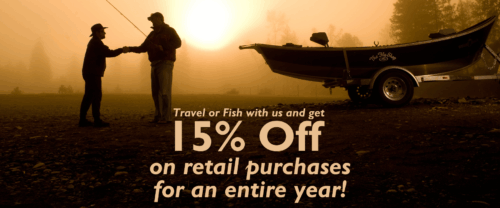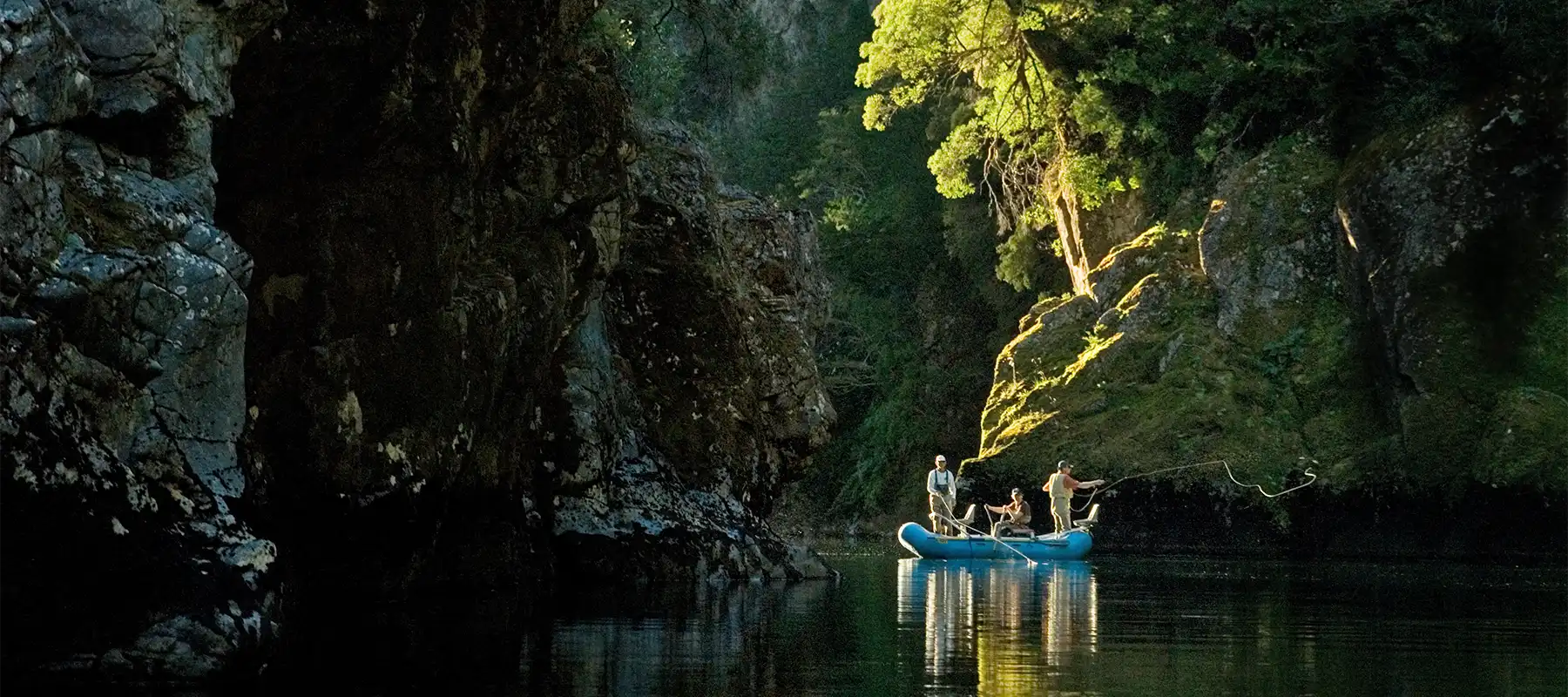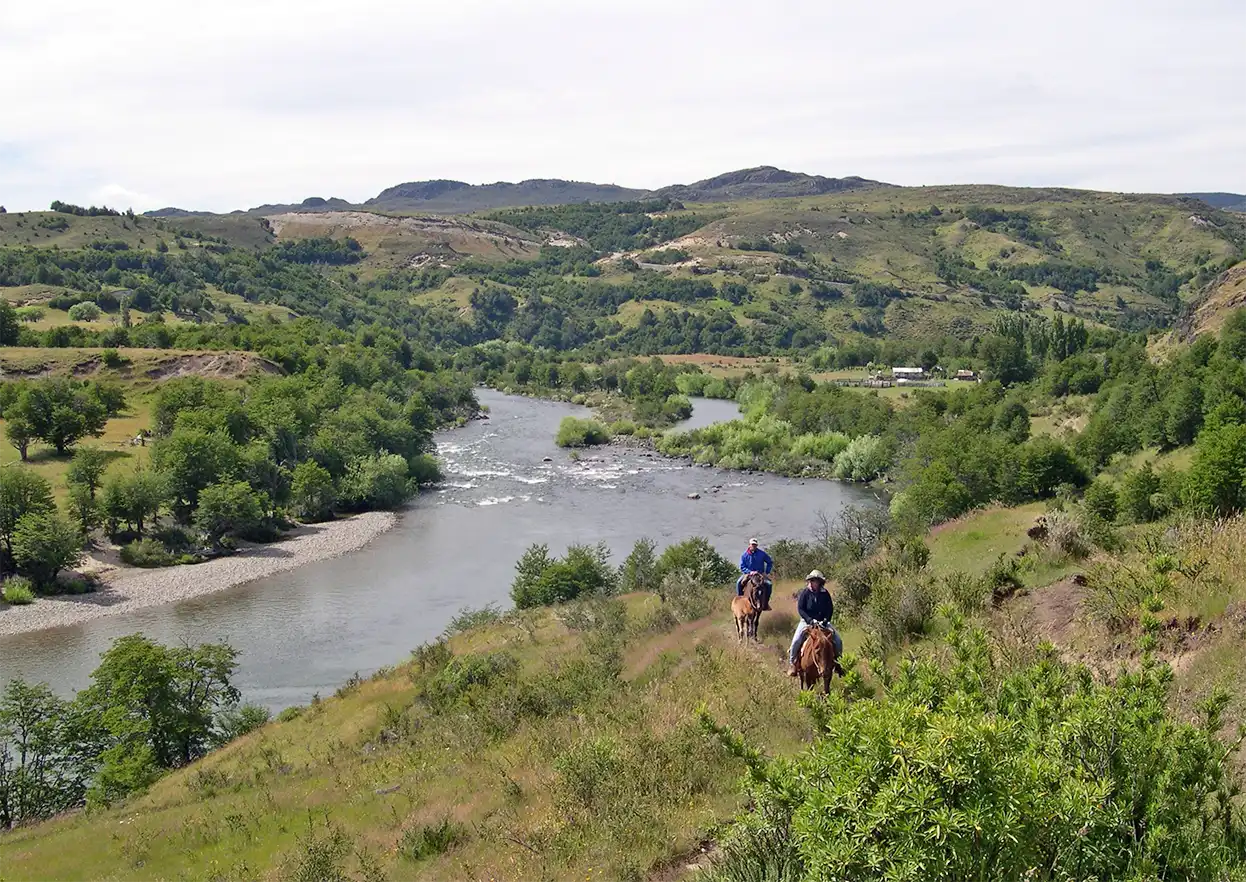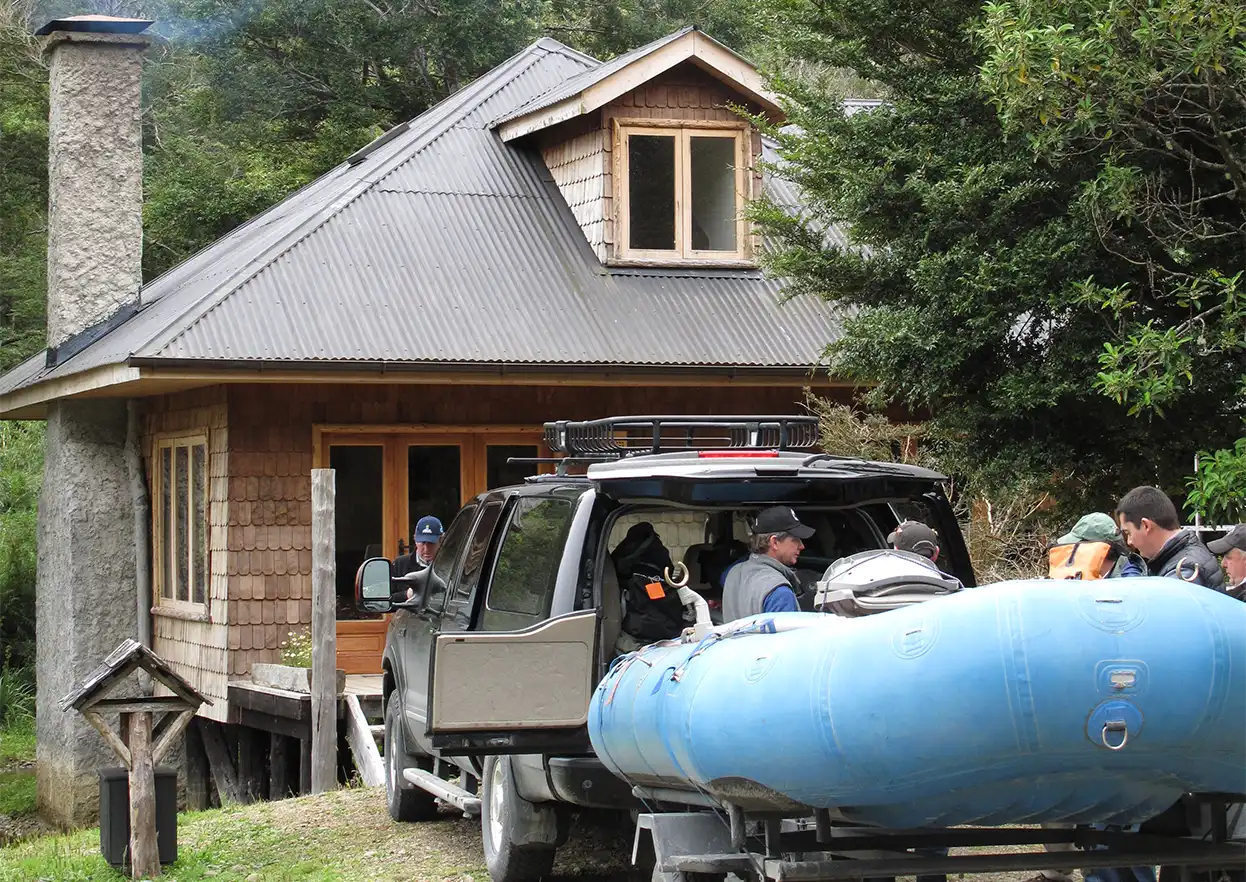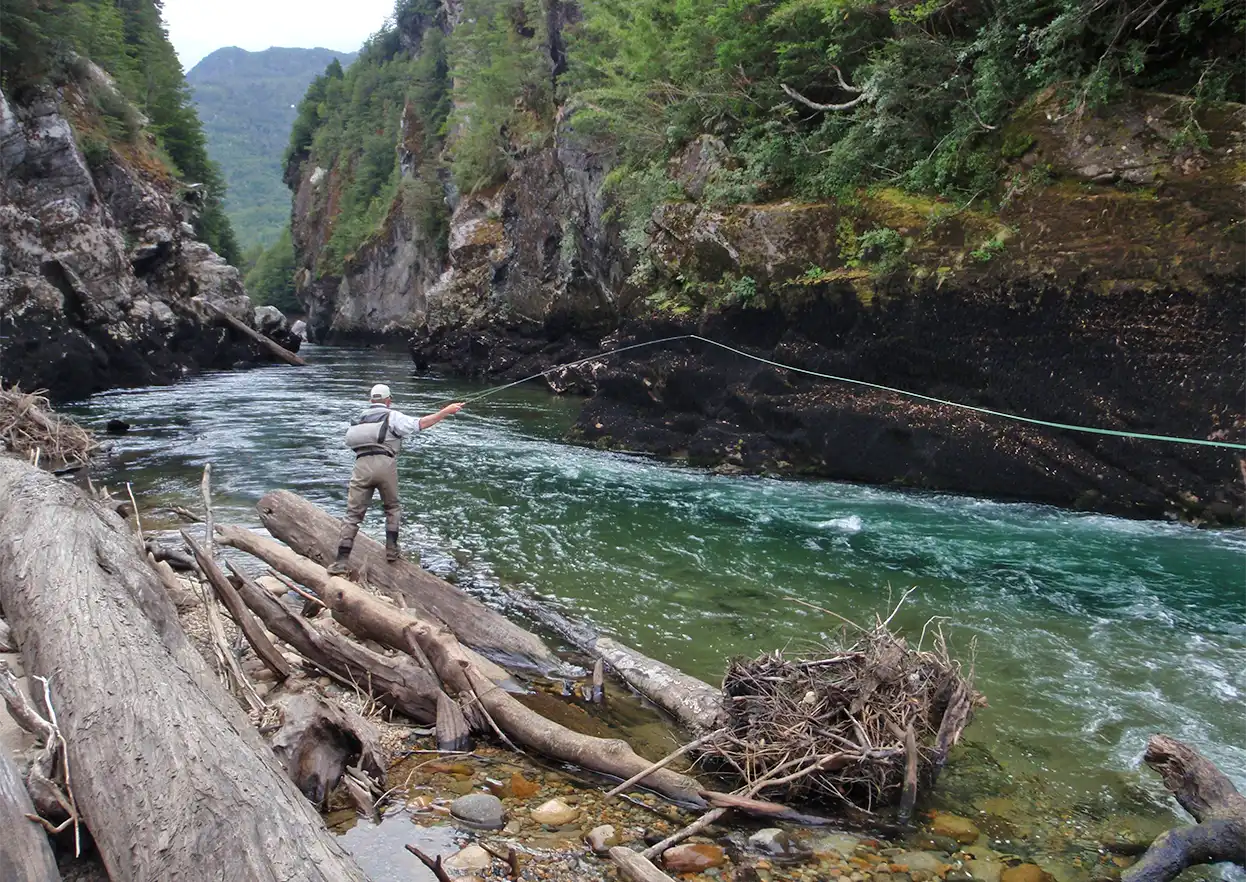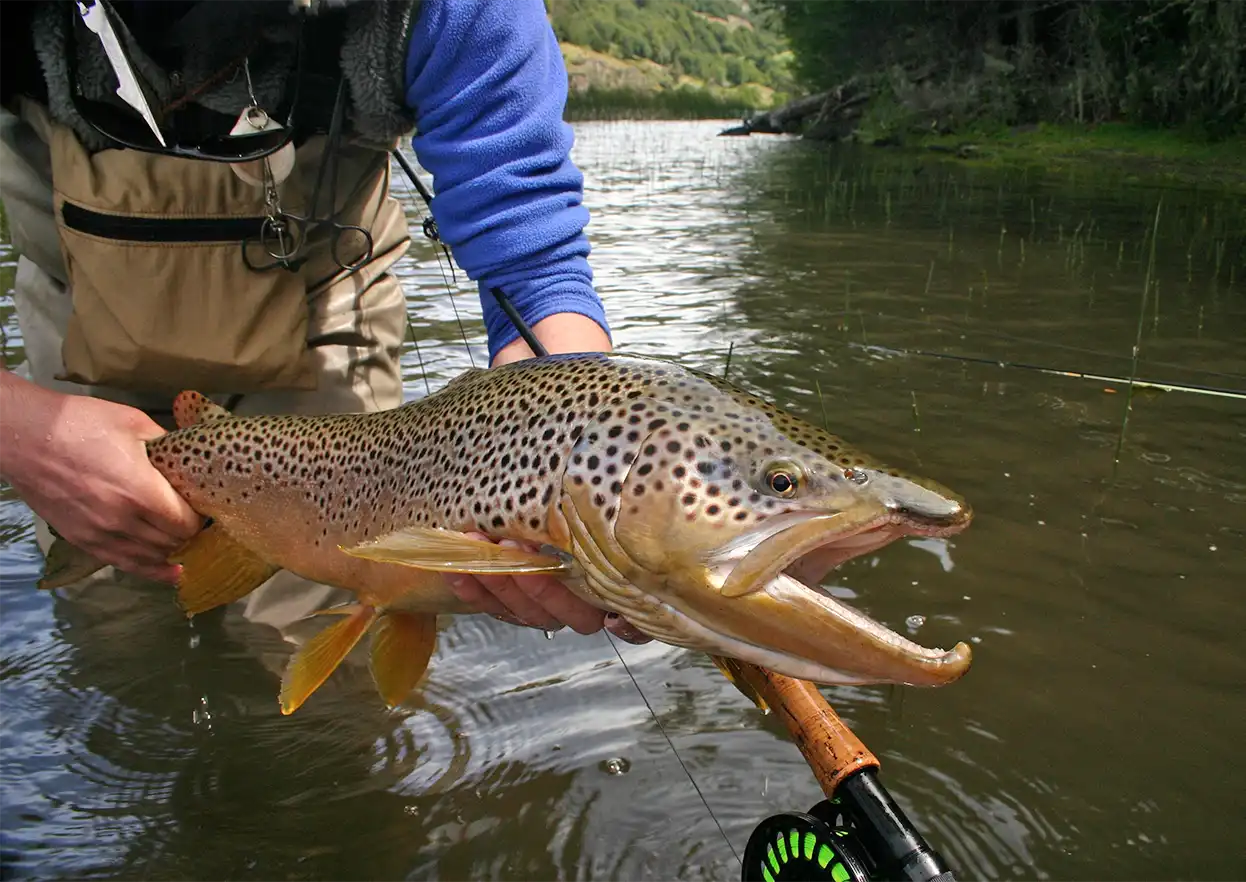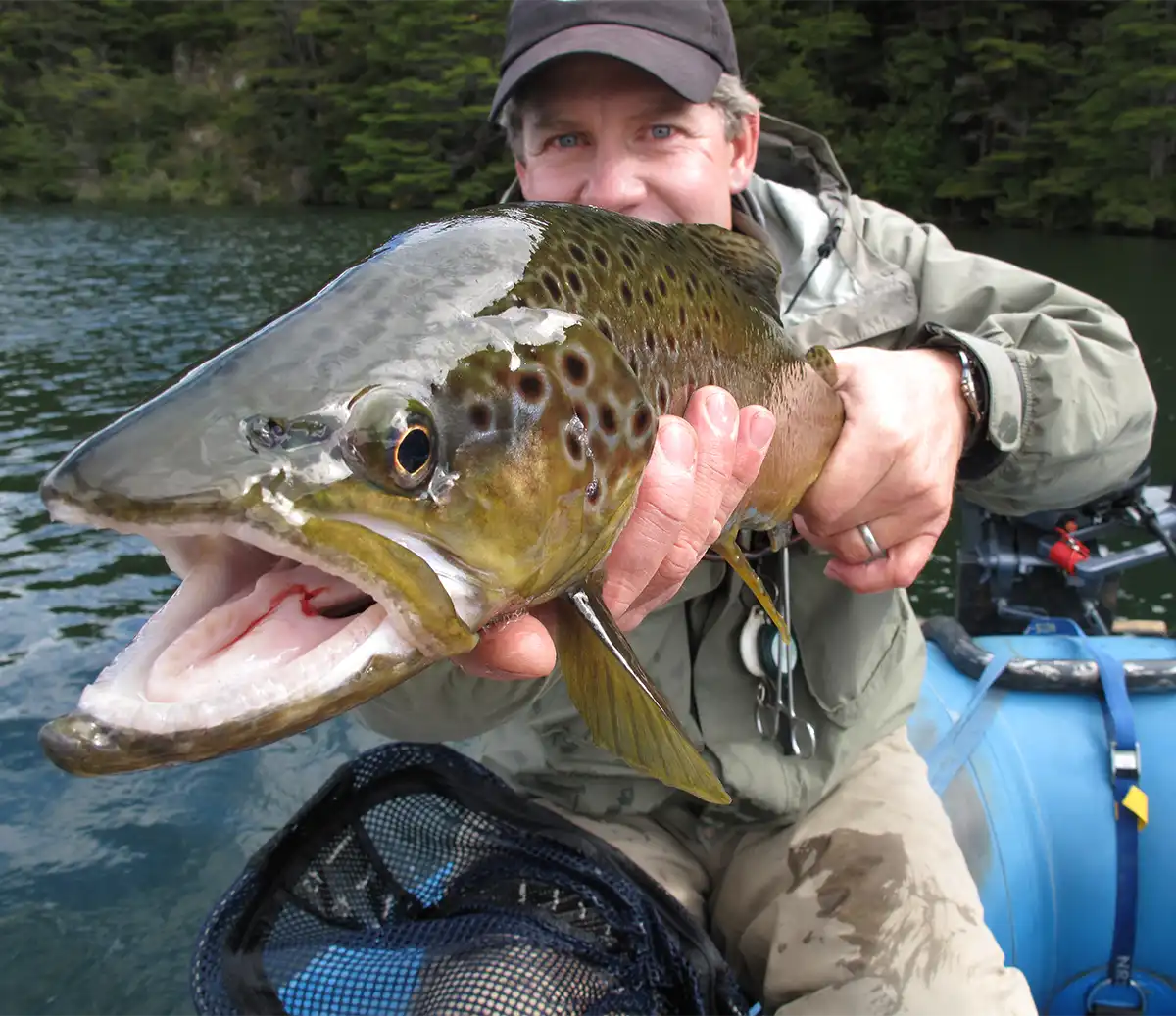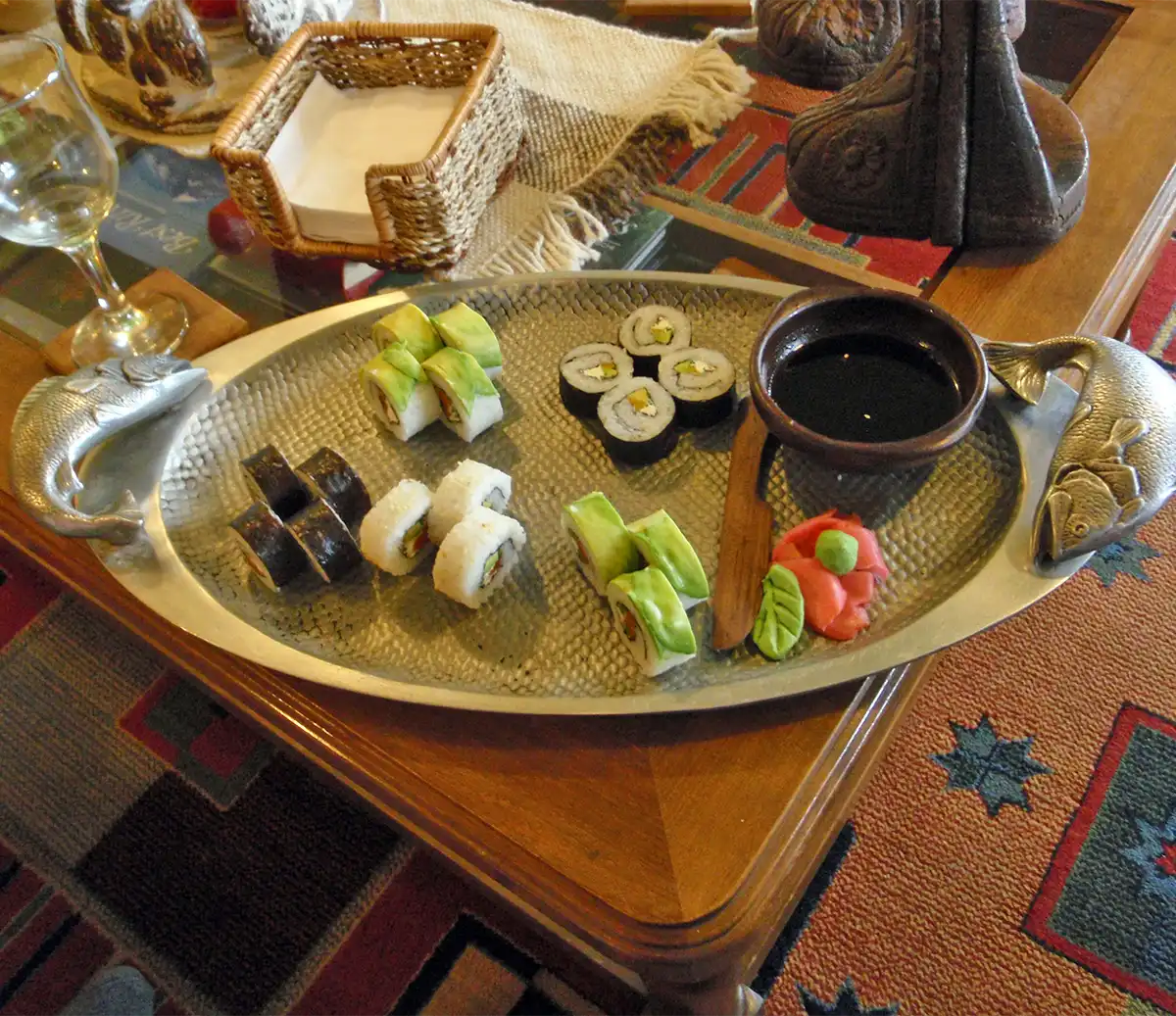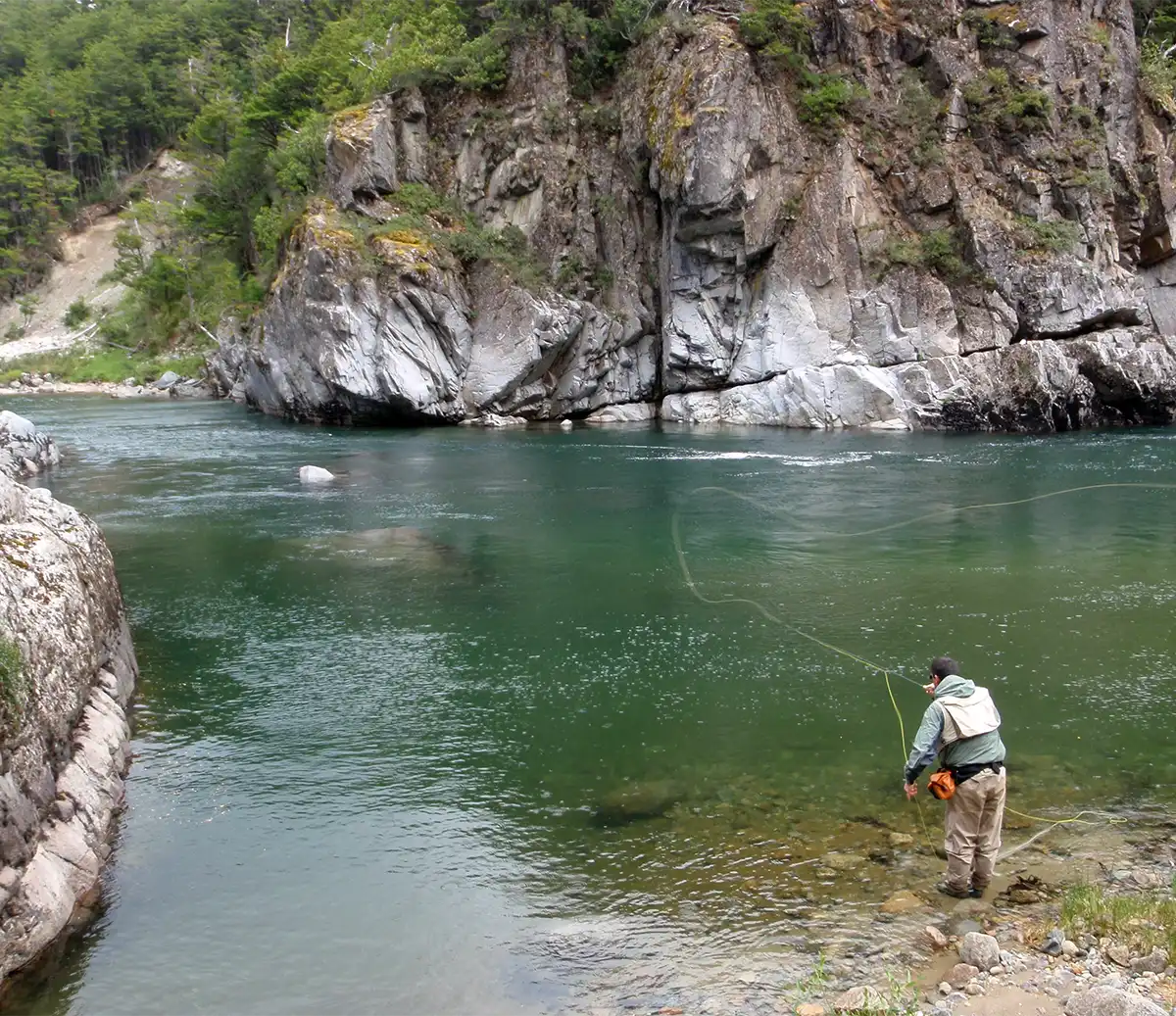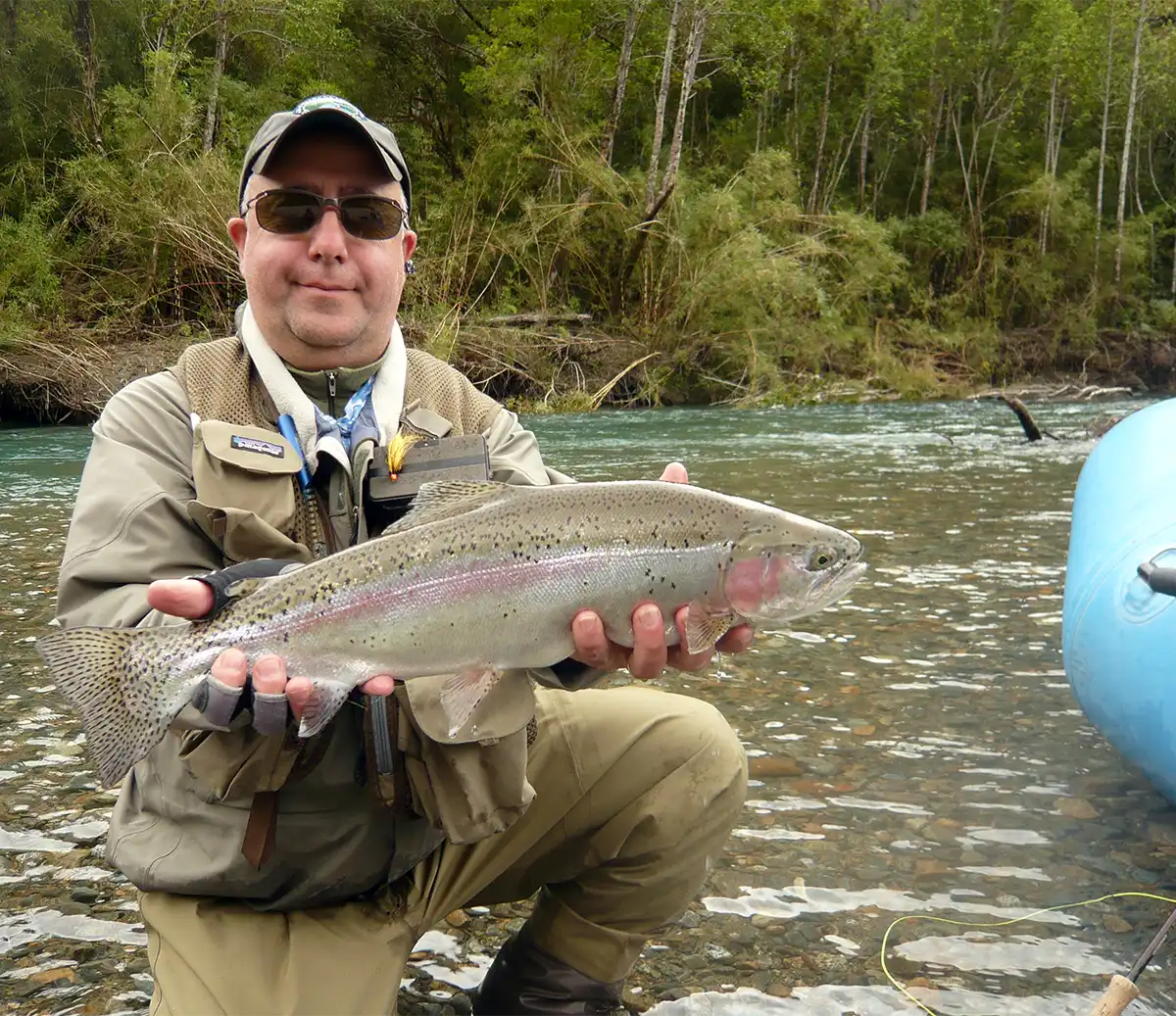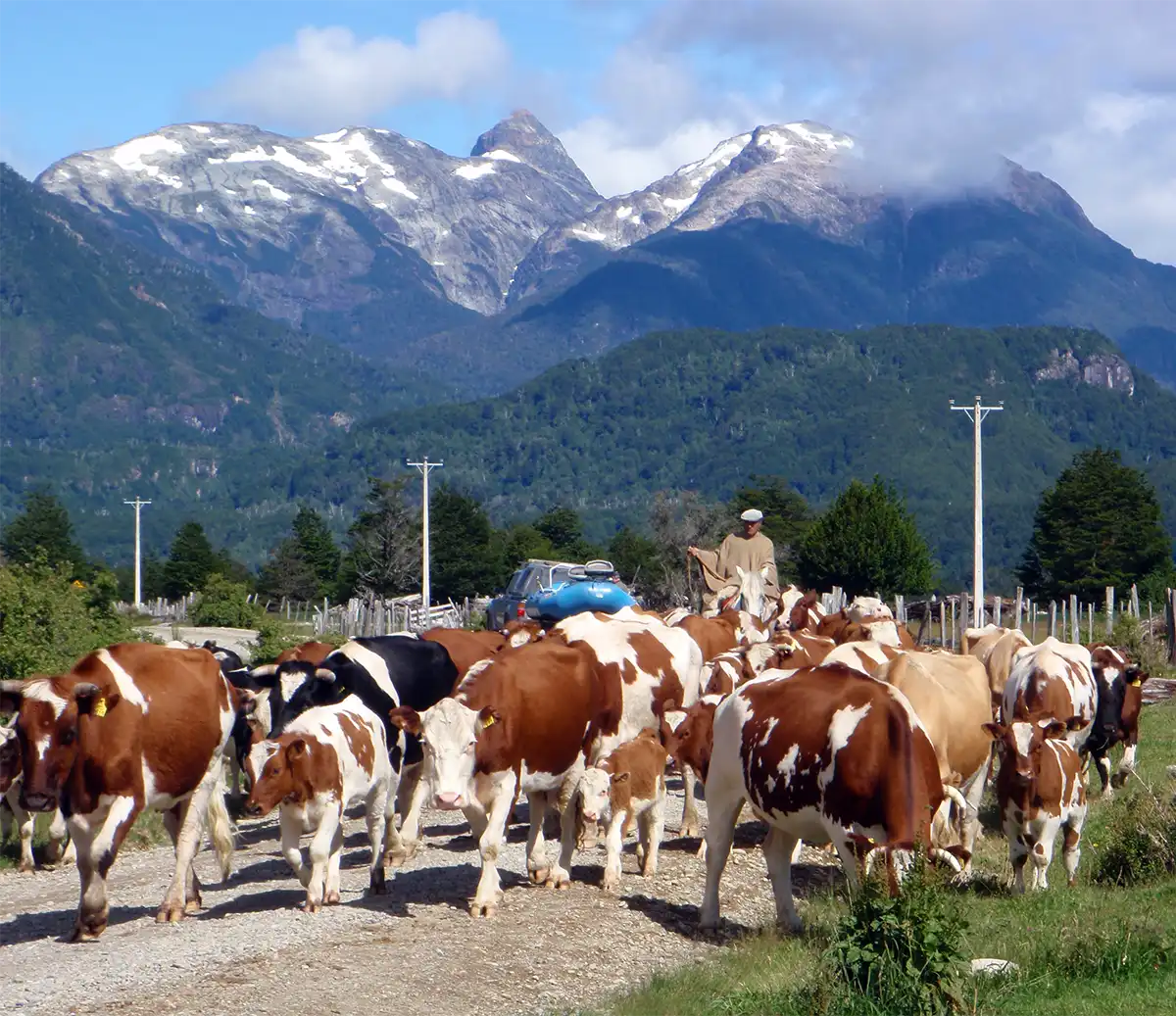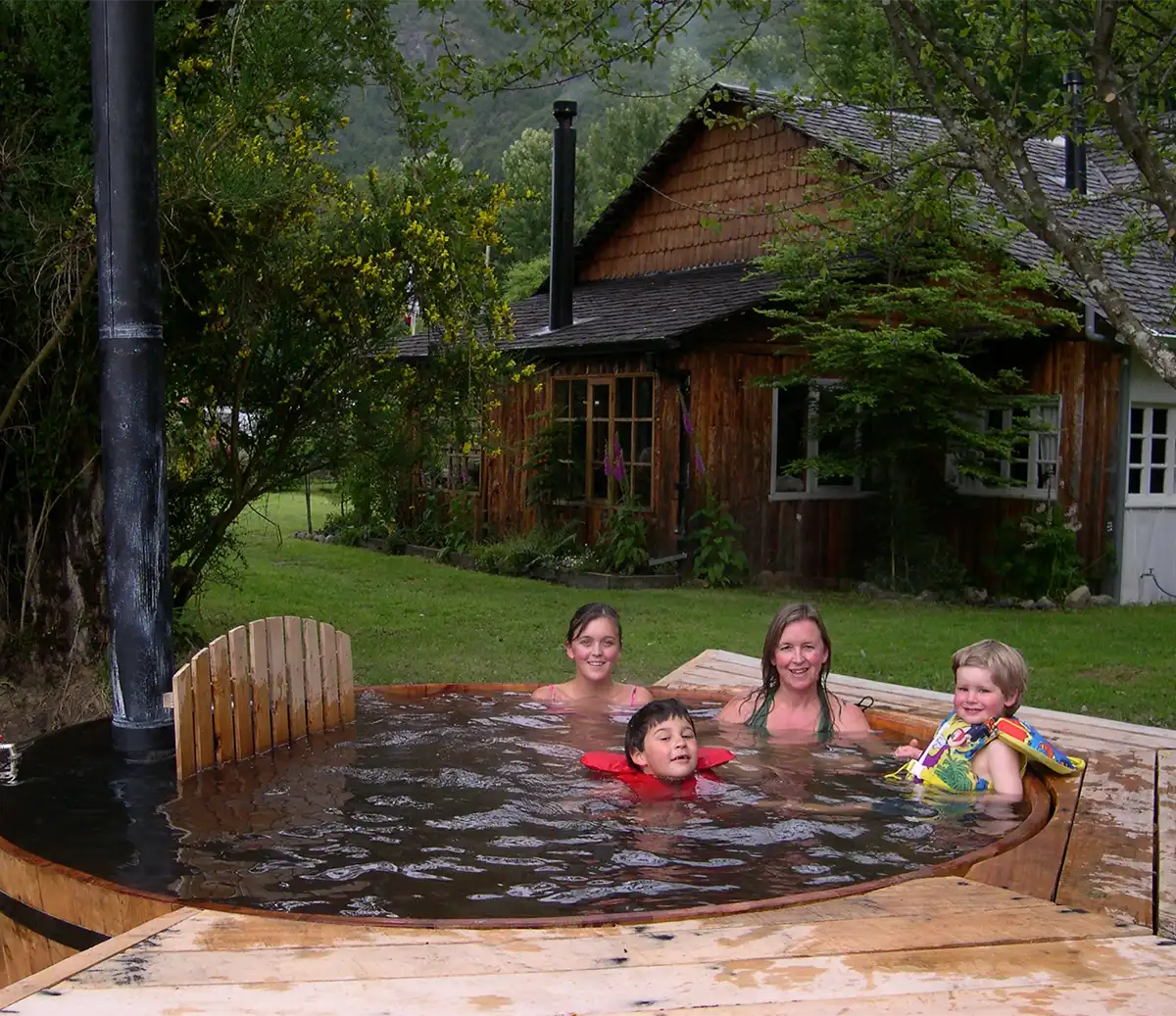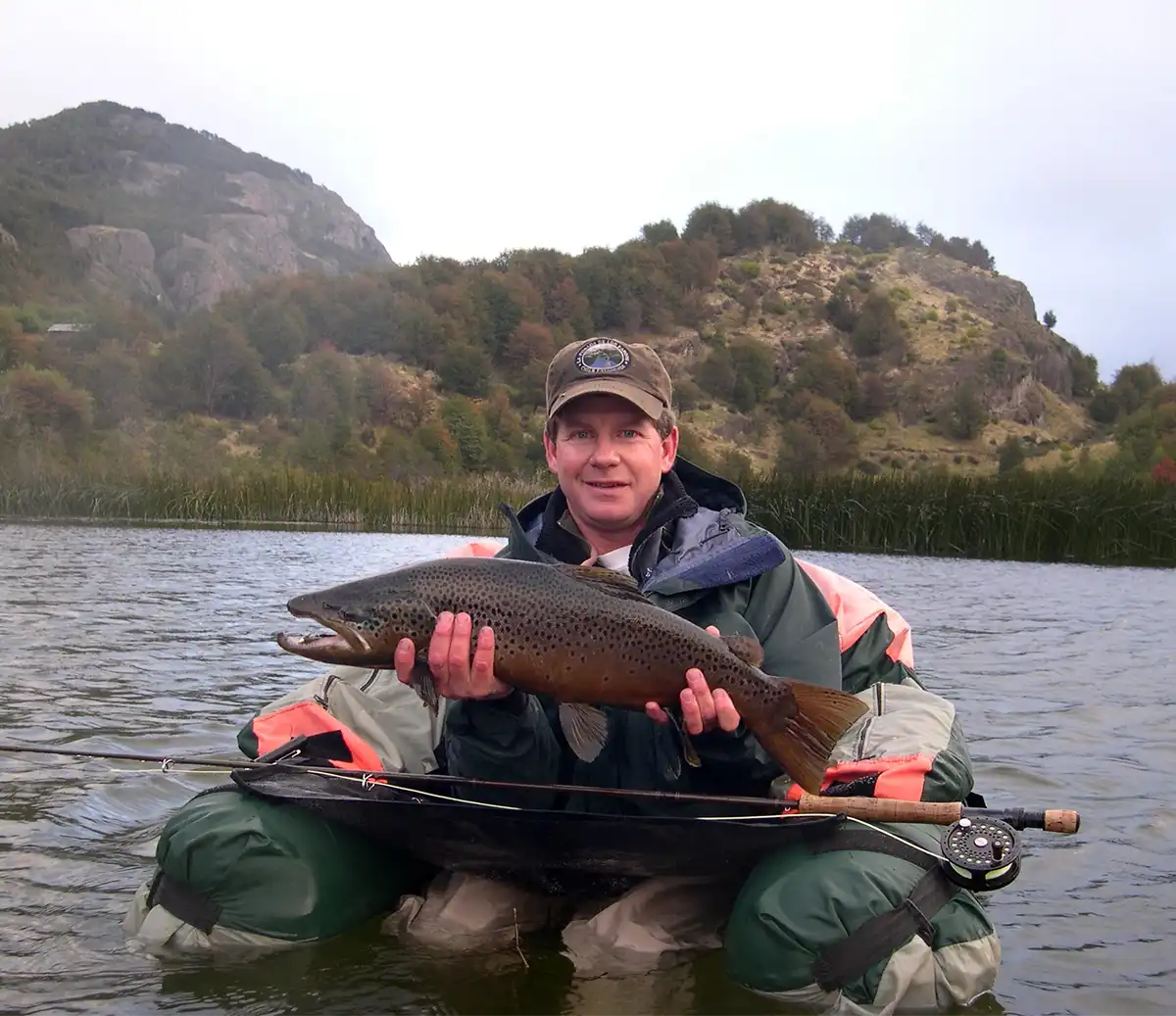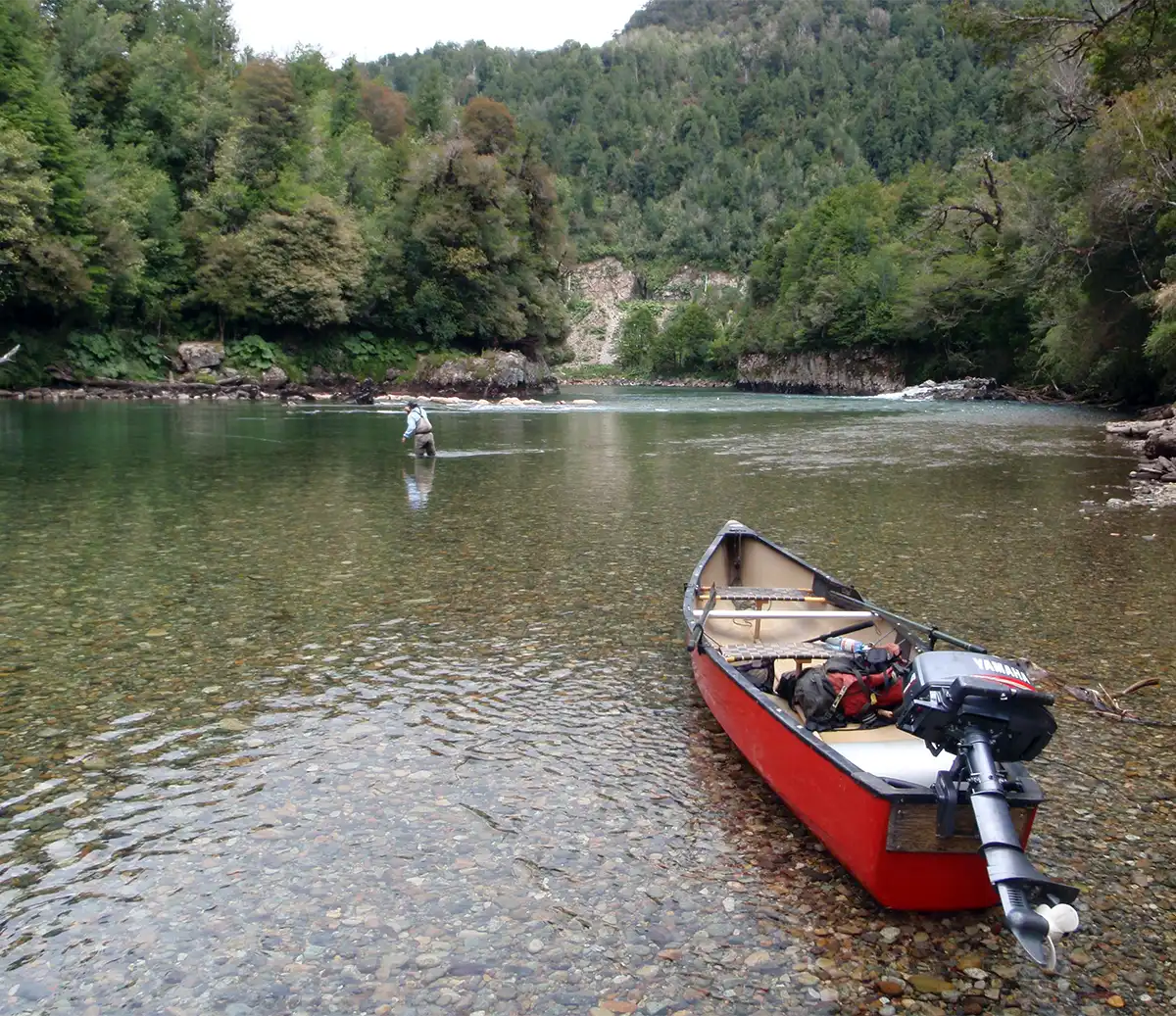Fishing conditions at La Posada range from very easy to demanding, and fishermen of all skill levels and ages can expect to do well in normal conditions.
The shallow tributaries support healthy numbers of smaller brown trout, offering non-stop action for anglers using high floating dry flies and grasshopper patterns, while the lagunas and large serpentine sections of the main stem of the Cisnes harbor healthy numbers of mature wild trout. These Browns are often thick in many of the regional rivers, lagunas, and spring creeks. There is also a moderate run of King salmon that can on occasion be targeted. Very few of the wading destinations at Los Farios are challenging or difficult. Anglers often choose to wade "wet" in the intimate spring creeks and lagunas, and use lightweight waders for the deeper portions of the river that require more aggressive wading. State-of-the-art angling rafts with rowing frames are on hand and the day long float trips offer a Montana-style accent to this terrific South American experience. The Cisnes Medio region forms the border between rain forest and dry pampa, at approximately 1,000' elevation. The weather is very reliable, and the warm Chilean summer is pleasantly accented by a few showers. Sweaters and rain jackets might be required, as the weather can be variable as fall approaches.
The Angling Week:
These are full fishing days, and the exact schedule will depend on the guest's wishes. Breakfast and dinner will be served in the lodge and fine mid-day meals are served in the field, stream-side.
La Posada de los Farios angling is exclusively for brown Trout in the Cisnes River, and a combination of rainbow, brown trout, steelhead, and Silver salmon on the coastal streams and estuaries. The fjord lands are a wonderful angling option accented by spectacular scenery and occasionally superb fly fishing.
The fishing on the Cisnes is done either on foot from a variety of access points along the river, or any of a series of day-long float trips. An optional overnight float trip is a terrific introduction to water that is seldom seen in the region, and Rex and his guide staff have several superb lakes within easy striking distance of the lodge.
The Upper River Float (moderate to difficult):
Starts roughly 1 hour upriver to the east of the lodge. This is a 10 mile float and can make for a very long day. However, it can be broken up into 2 parts if anglers are willing to make an approximate 1 mile hike out from the river to the road at the 1/2 way point. (It is a moderately difficult hike along a dirt road with a short but steep uphill ascent of approx. 300 yards. This float section is the highlight of our fishing program both fishing wise and scenically. It flows through semiarid mountainous terrain and can offer excellent dry fly action with the right conditions.
There is one class III rapid to be navigated about 3/4 of the way through the float. We typically fish large attractor dries like Chernobyls, Fat Alberts, Gypsy Kings and Hoppers. However, streamer fishing can be very productive as well, especially with wet high water conditions. Wooly Buggers with white rubber legs typically work the best. Fish on this section average between 15-18 inches and anglers often have shots at fish 20 inches or better. We sometimes make stops to fish one of the several spring fed lagunas or small spring creeks that are accessible along the river where larger trout can be found and often sight-fished to. From the take out it is about a 40-minute drive back to the lodge.
Lodge Float (easy):
This float starts right from the lodge and is about 6 miles long. This is a good place to start the week after the long trip down to Chile. This section is wide and meandering and floats through some old growth Coihue (coy-way) forest that makes up the transition zone between the drier Patagonian steppe and the coastal temperate rain forest. Fish average 10-14 inches on this section of the river and are very abundant. This is not to say that larger fish cannot be found here! All of the very largest predatory browns (25 inches +) we have caught from the lodge have been on this section of the river. The river passes by 2 small tributaries, The Rio Las Torres and the Rio Rodriguez, and anglers may stop to fish the lower sections of either one of these, as well.
Again, we typically fish large attractor dries like Chernobyls, Fat Alberts and Gypsy Kings. Black-bottomed foam flies seem to be the most productive - we believe this is because fish are always on the look out for beetles that are especially abundant in this area. Every 2 years we experience a prolific hatch of the huge Cantaria beetles (large stag beetles) from mid December through February. Streamer fishing can also be very productive, especially with wet high water conditions. Wooly buggers with white rubber legs perform very well. From the take-out it is only about a 15-minute drive back to the lodge. This float can also be done in 2 parts. We often offer the upper ½ of this float as an option on a guests day of arrival.
Lower Canyon Float (moderate to difficult):
This float option has been opened up as a result of the expansion of the "Carretera Austral" or "Southern Highway". The float begins about 25 kilometers down river to the west of the lodge (30 minutes). Here the river delves into the lush coastal rainforest with even more rugged and spectacular glaciated mountain terrain providing for the back drop. Along the way to the put-in we pass by Villa Amengual, a quaint rural village of about 200 inhabitants and our closest link to civilization. The river gets big down here and flows several miles away from the road and, due to the fact that there is a tricky class IV rapid to be negotiated, we will only undertake this float when the water flow conditions are favorable. We choose not to chance making this float during too high of water conditions and, for safety reasons, we will only operate this float as a two boat trip. It is hard to imagine a more spectacular float in Chile or, anywhere else in the world for that matter. The river is big, the mountains are big, the forest is lush and primeval and, although the typical brown is not overly large, we have seen some truly monster browns come out of the depths on nearly every trip we have made down there, especially in the tight canyon sections along the rock walls. We believe it is only a matter of time before someone lands a 30+ inch fish down there. It is challenging fishing, often throwing large flies on heavy sinking lines but, there is the very real possibility of catching, or at least getting a glimpse of, that brown trout of a lifetime.
The Rio Manihuales (easy):
Due to the present paving of the Carretera Austral (Southern Highway) it will now be reasonable for us to add the Rio Manihuales to our float fishing options. There are 3 or 4 floatable sections of this river from about 45 minutes to 1 hour and 15 minutes away from the lodge. This will be our closest and only option (aside from the coast) where we can fish for rainbow trout in addition to brown trout. The Manihuales is a large river and best fished from a boat. The river is rugged with immense logs lining the banks in several areas providing for excellent structure for larger fish. Deep pools with high rock walls on other sections also provide great habitat for large fish. The terrain surrounding the Manihuales is very similar to the middle Cisnes area near the lodge and highlighted by spectacular views of Cerro Picacho, an impressive peak reminiscent of the Matterhorn. The browns and rainbows of the Manihuales average good size and it is almost a given that someone during the day will land a fish in excess of 20 inches during a days float.
Lower river wade options (moderate to difficult):
There is some moderately easy wading to do right in front of the lodge that becomes easier the lower the water gets. During high water we will suggest floating instead. This is a good option on the day of arrival.
About 10 minutes up from the lodge there is a gorgeous wading option at a place we call Jose's. This is moderately difficult wading and involves and fair amount of walking. The river bottom is primarily large cobbles and boulders, but not slippery, nor is the current overly fast. This section of the river is very rarely fished. It is quite scenic here where the river leaves the rugged canyon section of the river called La Garganta ("The Throat"). A few seasons some of our guests spotted a rare Huemul deer here at close range. Fish tend to average small, 10-14 inches but are abundant and we often do very well here fishing smaller dries. Especially productive are small (#14) black beetles, but larger attractor dries also can work well. We typically bring a raft with us to cross the river and to fish a large pool that is inaccessible wading and where we have the best luck for larger fish. There are also a couple of hidden and protected oxbow lagunas here that can produce some nice size trout, and are a nice respite during windy days.
The New Zealand Hole (moderate to difficult):
There is also another wading area just up river from here we call The New Zealand Hole, named as such because it is a deep canyon pool like what I have always envisioned it to be like in New Zealand. It involves a ¼ mile walk down a moderately rugged trail. This is where the lodge record brown (31 inches) was caught once during high water conditions; a 28 inch fish was also caught here the same day, both using streamers. It is a gorgeous place to fish with steep granite walls surrounding a deep bottomless pool. This is a good place to spot large browns that are very difficult to trick into eating a fly. However, it is rugged and only recommended for agile anglers who are able to scramble over steep rock along the river's edge to get into position to present a fly.
There is some relatively easy wading where the pool tails out. Dry fly action can be very good here but, as is typical with many of the deep pools along the Cisnes, the fish can be very spooky and some very accurate casting is often required to be successful here.
Tributaries (easy wading):
There are 2 small tributaries, The Rio Las Torres and the Rio Rodriguez, located about 10 minutes downstream from the lodge that can be fun to fish. They are both reasonably easy wading. Getting to the Rio Las Torres involves using a raft to cross, or crossing using a small cable car that traverses about 20 feet above the water. Both rivers produce primarily small browns, but we have seen 20+ inch fish come out of both of them over the years. (We believe these larger fish are spawners that decided to stay in the tributary to prey on the smaller fish.)
The tributaries can be good options during windy days as they are relatively protected. We access another tributary called the Canelo River about 10 minutes up from the lodge that can also be a lot of fun but, the wading can be moderately difficult as it is very rocky. All of these tributaries are only good for a few hours each so we will sometimes move from one to the next to make a full day out of it.
The Moro River (difficult):
Another productive tributary that comes into the Cisnes about 40 minutes up-river from the lodge. It has a very scenic canyon with nice pools and is relatively arid and protected. Dry fly action can be very good and we often find larger browns in each of the main pools. It is tough wading and only recommended for the anglers who are strong waders and hikers and up for a good strenuous adventure.
The Upper Upper Cisnes (easy):
Larger average fish (14-18 inches) on this section. About 1 hour up river from the lodge the Cisnes splits and the southern branch becomes a small and very easily waded river that could probably best be described as a creek. This is where the mountains begin to fade giving way to the vast open Pampa to the east. Conditions tend to be windier here because of the relative lack of protection. This section can make for excellent dry fly fishing especially, during the hopper season from (mid-January through mid-March) and then afterwards as the mayfly action gets going, from mid-March on. There are 2 main beats we wade fish on this section. There are also several small spring-fed lagunas that are accessible in this area that can produce some larger trout. Fishing these section can involve a good amount of walking (1-2 miles) over flat easy terrain.
The Main Upper Cisnes (easy):
About 50 minutes upriver. This is also relatively easy wading with small gravel but, bigger water than the upper Upper section (during high water times we typically opt to float fish rather than wade this area). Again, dry fly action can be excellent during the hopper season from (mid-January through mid-March) and then afterwards as the mayfly action gets going, from mid-March on. There are 3 main beats we fish here, all of which provide access to some of the spring fed lagunas or small spring creeks that can provide for good dry fly action for larger fish. Sight fishing is often possible in these lagunas. Again, a fair amount of walking (1-2 miles) over easy terrain is required to best take advantage of the fishing options in this area. River crossing can be difficult, especially during higher water conditions.
Lago Las Torres (easy to moderate):
Located about 20 minutes form the lodge. Surrounded by jagged mountain peaks that literally rise up to over 1 mile above the lake's edge. It is hard to imagine a more scenic setting. The lake is surrounded by a lush and ancient old growth temperate rainforest and completely protected within the 40,000-acre Lago Las Torres National Reserve. There is a very healthy population of
brown trout that average 18-22 inches and are spectacularly colored due to the rich organic quality of the water. Dry fly action can be superb on warm days as the browns aggressively hunt adult dragonflies cruising just above the water's surface. It is common to see large fish launch completely out of the water to capture dragonflies several feet above the water. They will often exhibit the same aggressiveness towards a large attractor dry fly, such as a Gypsy King, when effectively presented. The explosiveness of the takes can be unforgettable. There is a tremendous amount of structure along the edges of the lake with numerous large logs, weed beds and reed areas. There are several shallow open areas between the reeds and the shoreline where large browns can sometimes be stalked and sight-fished to.
Hidden Lagoon (moderate):
There is a remote and very productive hidden laguna (where we keep an Outcast boat) that is connected to the main lake via a small creek. It involves a moderately difficult 1/4 mile trek through the jungle to reach it. The fishing in the laguna can be excellent for fish averaging 18 inches and better. It is very protected and a good place to be during windy conditions.
Lago Los Farios (private lake):
For many people, the thought of lake fishing conjures up images of vast, featureless expanses of water and hours of mind-numbing trolling, hoping for some unseen denizen of the deep to somehow find their lure and bite. Not very scintillating stuff. The lake and laguna fishing at Rex's couldn't be further from this kind of picture. Imagine instead small, manageable-sized lakes and ponds, the kind you can often float tube around in an hour, or less. Visualize shallow, clear water, where you can see many of the beautifully- marked 12 - 20 inch browns before you cast to them. Consider that these fish see only a handful of anglers each year, and often rise eagerly and aggressively to large dry flies, as well as chasing midsized streamers and nymphs. In addition, some of the lagunas are tiny; the kind you sneak up to, not really believing anything bigger than a guppy could possibly live in, then stand slack-jawed as a big brown head engulfs your hopper off the surface, the owner of which, when you set the hook proceeds to cartwheel wildly across the top of the water. No, trolling this DEFINITELY is not!
It's a great trip for those who enjoy riding horses. Our horses are very mellow. It's a relatively easy 1.5 hour ride (4 miles) beginning in arid open country on the upper river where the mountains just start to begin to settle down before melding into the open Patagonian pampas to the east. The trail rises up several hundred feet through this spectacular open mountain country before eventually leading into an old growth Lenga forest (Southern Beech) that surrounds the entire lake.
"The lake (which we are now calling Lago Los Farios) is a mile and a half in length and truly pristine with fantastically clear water. One of our guests and guides last year had the rare experience of sighting an endangered Huemul (Andean Deer) close up as it waded along the lake's edge. There is a very large and healthy population of brown trout that averaging between 15 - 19 inches that are incredibly stout and hard fighting. We believe that a prolific scud population is what contributes to their exceptional condition. Dragonflies are abundant and we often have great success taking fish on large drys (Gypsy Kings, Chernobyl Ants, etc.) throughout the season. As always, weather conditions dictate the techniques that we employ to take fish, with warm days typically providing the best surface action." - Rex Bryngelson
